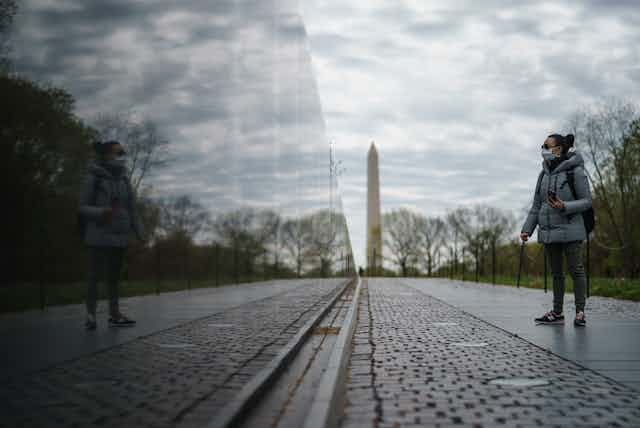At some point in late April 2020, COVID-19 claimed the life of its 58,221st victim in the United States. We do not know the victim’s name or the exact time of death, but the death was significant: It meant that the coronavirus had claimed more American lives than the entire Vietnam War.
That conflict, which lasted from 1955 to 1975, resulted in the deaths of 58,220 Americans. COVID-19 surpassed that number in less than four months.
Much like the nightly death counts that took place during the Vietnam era, the grim figures of the current crisis can obscure the fact that those who have perished were human beings, mourned by those they leave behind.
As a veteran and historian whose research examines burial rituals, I know that the way Americans memorialize the dead is steeped in traditions that are both social and cultural. COVID-19 is complicating these longstanding traditions.
The virus is also making many people think about their own mortality in ways they have never done before. As Princeton scholar Eddie S. Glaude Jr. recently wrote in the Washington Post, with COVID-19 Americans can no longer “banish death to the far reaches of our communities.” Instead, “Death is at our doorstep.”
A ledger for lives
In the war of attrition in Vietnam, the U.S. servicemen and women who lost their lives often became enumerated alongside their peers – relegated to a single numerical point of reference among the tens of thousands who died.
Then as now, newspapers and televised coverage included daily casualty reports as the government released the official numbers from Vietnam. These reports became a standard part of newscasts and developed into the central focus of efforts to combat the war.
The daily summaries helped normalize Vietnam deaths in the minds of Americans. The names of the American war dead were listed in numerical order by the date and time of death. Victory was assessed by the number of casualties inflicted upon the enemy. The daily ledger of all combatants who died on both sides of the conflict was used to suggest that America was winning the war.
As a consequence, quantitative data replaced the faces and names of the lost, dehumanized the war dead and influenced an obsession with raw data over traditional means of assessing progress, such as gaining or losing territory.
And much like today, the numbers became politicized as Americans’ trust for their leaders began to wane. Many, both then and now, sought alternative measures to account for the dead.
Media portrayals of the Vietnam conflict furthered this dehumanization by depicting the motionless bodies of American dead. Rarely were the names of the those killed in action included alongside these images.
Such media accounts helped to guide how the public processed death during Vietnam.
Death during crisis
The war against COVID-19 has continued these practices, immersing Americans in daily death totals against an enemy not fully understood. Daily counts of the dead, tests conducted and their results, compiled against the backdrop of overall percentages, is seen to determine success against the coronavirus.
Then as now, images of lifeless bodies with no names attached are shown – only now they’re being carted into refrigerated trucks.
In addition to the parallels in the way the dead are converted into quantitative data, Vietnam and the pandemic also share similarities in how the deceased are being mourned.
Vietnam veteran Bill Hunt wrote in 1990 that “In the end, all wars are about dying. When the dying is about honor, it is somehow OK.” But during the Vietnam War, public sensitivity to the number of dead and apathy toward the conflict actually decreased support for what the American public viewed as “sunk costs” and the loss of 58,220 lives.
Due in large part to this lack of understanding among Americans about what their loved ones were dying for, the casualties of the Vietnam War placed emotional strain on those grieving a lost service member. Deaths from the conflict were often mourned privately and without public celebration.
The same has been true of COVID-19 victims. Due to fear of contagion, families are unable to be present at hospitals during the final days and minutes of their loved one’s lives. An overburdened funeral industry and shelter-in-place orders also mean family and friends cannot bury or memorialize their loved ones in traditional ways such as by holding a wake or funeral.
In both the battle against COVID-19 and the Vietnam War, this isolation makes mourning, burial, memorialization and saying goodbye both problematic and private. As a result, reconciling the loss of their loved one is much more arduous and making it harder for those left behind to find closure and process their deaths.
Public remembrance
Eventually, the names of the service members who died in Vietnam adorned the Vietnam Veterans Memorial Wall in Washington, D.C., acknowledging publicly for the first time the sacrifices of those who died. Having a permanent place of remembrance helped to ease the pain of those untimely deaths.
We do not know if those who perish during the current pandemic will be memorialized in a similar fashion. And sadly, not everyone will receive an obituary in which details of their lives can be read.
It may be that we have to find new ways to reconcile the deaths of those who lost their lives in the fight against COVID-19.
But to move on, we must acknowledge the men and women who are dying, give them names and faces and publicly honor them – not only for the dead but for the living who continue to mourn.
[Get facts about coronavirus and the latest research. Sign up for The Conversation’s newsletter.]

